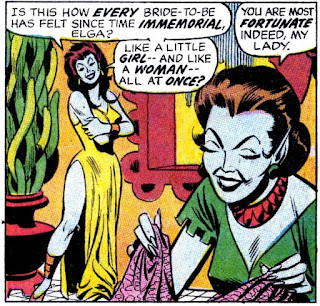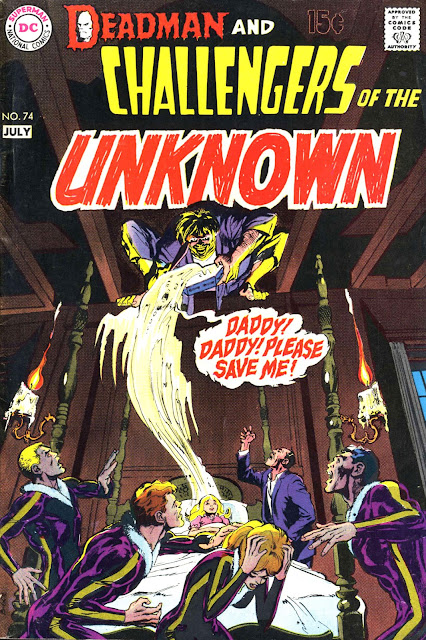SUB-MARINER #36 April 1971
'At Last! The wedding of the Sub-Mariner' declares the strapline on the cover of #36 dated April 1971, but on sale at the start of January that year. A few weeks ago I looked at an assortment of comicbook covers which depicted wedding scenes of characters ranging from Superman to She-Hulk, and uniformly they showed that moment when the couples being betrothed were standing before a priest, the marriage declaration about to be made. Here we have an altogether different picture, one of carnage and destruction-- The image is a classic pulp sci-fi/fantasy composition-- we have the muscular hero under attack from an aggressive, destructive enemy and we have the beautiful, scantily-clad maiden being carried protectively by him. The death-rays, explosions, somersaulting bodies and destroyed city all speak of war not love, division not communion. If this is a wedding, then it's the wedding from hell, the juxtaposition of the strapline with the image giving the cover a wonderfully ironic charge. A ceremony which should be positive and sacred and peaceful under threat by violent insurrectionists desperate to prevent the event from going ahead.
The opening splash-page depicts the very masculine Namor diving diagonally downwards, his hand outstretched as he seeks out Proteus to officiate at his forthcoming wedding to Dorma. 'Where were you on the wedding day of the Sub-mariner?' the caption asks, setting up a series of such questions throughout the issue, each time directed at a different character involved in the storyline.
The following page starts with a frame which symbolises the tension at the heart of the entire issue. Namor, almost completely obscured by shadow, reaches forward as he is about to enter a circular cavern hidden deep in what the previous page's caption describes as 'a wine-dark world that never sees the sun'.
Together writer Roy Thomas and artist Sal Buscema (ably assisted by Berni Wrightson on inks!) lace the narrative with sexual symbolism to underline Namor's plight. So, the sight of our male hero paused at the cavern's entrance represents the way that he is on the verge of consummating his relationship with the virginal Dorma. The shadow works not only to suggest that he is on unfamiliar territory himself in terms of his activities with women, but also hints at the as-yet-hidden problems which lie ahead this issue.
Then, when the crowds cheer the appearance of Dorma, fittingly she is depicted standing the other side of another opening, this time a window. Thomas's script indicates to the letterer to highlight the word "window" to further emphasise the symbolism of an entrance which is out of reach of the crowds of mostly excited men gathered below. And in case that's not enough, Buscema assists by including at least six upraised arms, most of which are pointing unambiguously in the fair lady's direction--
"Is this how every bride-to-be has felt since time immemorial, Elga?" asks Dorma in the next panel, her face a vision of a woman approaching ecstasy-- "Like a little girl -- and like a woman -- all at once?" Has there ever been a more blatant description of a first sexual encounter in a publication bearing the Comic Code's seal of approval?
Mid-way through the story the Prince of Atlantis is brought by Proteus to another cavern opening, which this time he describes as a "nameless grotto". Proteus challenges his description and instead describes this place as "the most sacred place of all", a fairly blatant euphemism for a male's perception of a woman's sexual parts. The fact that Namor is forced to pause again ahead of his wedding foreshadows the story's later events in which he is delayed in progressing to the ceremony.
But the creative team decide that each time Namor encounters one of these cavernous openings what he finds inside is something very male. At the story's start it is Proteus himself who emerges from within the cavern's depths, his domed penis-tip-shaped helmet with its pair of rampant horns and his double-pronged staff all clear symbols of his own phallic power--
Similarly the second cavern conceals a statue of the patriarchal sea-god Neptune, with his triple-pronged symbol of phallic power, the trident, held prominently beside him--
As the pair stand dwarfed by the towering figure, Proteus declares that the statue will "symbolically watch over your wedding day", underlining the fact that the communion between Namor and Dorma is allowed within the constructs of a patriarchal society in which male prowess and strength is valued above all else.
The irony of this is that the future leadership of the Atlantean society is, unbeknownst to its Prince, currently under threat (spoiler warning!) from a malign feminine force. The readers have just been treated to a flashback sequence reminding them of the events of #32 in which Namor had been locked in conflict with the beautiful, but deadly Llyra--
And they have also just witnessed Llyra's grieving mother embark upon a process to revive her deceased daughter. So, in the back of the reader's mind for the remainder of the story is the strong possibility that the greatest threat to the male Namor will come from a far more feminine source--
But in the meantime Namor is forced to lock horns with "a fiend most foul", the very male antagonist this issue, Lord Attuma who has attacked Atlantis in its Prince's absence, a challenge to his authority as well as to his manhood on the brink of his opportunity to demonstrate his virility in marriage--
So we witness the Atlantean guards finding their weapons having "no effect" on Attuma's forces who attack in machines called Octo-meks--
The phalluses of the Atlanteans are proven to be no match for those of their aggressors, their masculinity is challenged and found wanting. Their guns are not good enough and they are forced to withdraw impotently--
Fittingly Namor's appearance on the scene shows him symbolically knocking the Barbarians' guns out of their hands in a movement which is drawn with an upwardly thrusting priapic curve, unambiguously suggesting his dominant virility--
The Barbarians counter by entangling Namor in the arms of a monstrous Octo-mek, but help is at hand in the phallic shape of an oncoming missile--
The weapon has been unleashed by Karthon the Questor, who is unsubtly depicted with a huge weapon emerging from between his legs--
But the antagonists' leader himself has not yet entered the fray, and on the following page we get to meet Attuma himself. Now, here's a guy with real masculinity issues. Unlike the other male characters in the story, the horns on his helmet droop downwards limply. He's the classic insecure male who has to over-compensate with shows of phallic superiority which he hopes will conceal his own inadequacy in that department. Not only does he vicariously rely on others to make himself seem more powerful -he has a lackey to carry an upright trident because he can't do the same himself- but he also shows off his supposed prowess with a huge vehicle to which he gives an absurdly aggressive name--
And just as a term such as 'The Beast' might bring with it laughable connotations of some kind of mighty male member, Attuma's penis-substitute, the "Weapon Supreme" also reveals its owner's irony-free intentions in its naming. The vehicle itself, a gold-plated tank with no less than four cylindrical forward-thrusting protuberances, is the kind of thing which would excite any wannabe megalomaniac--
But the would-be usurper's might is proven to be short-lived once Namor destroys the weapon, symbolically emasculating him in a moment of his own orgasmic display of strength, shooting explosively upwards from beneath the sea-bed--
Indeed once the golden weapon is gone, Attuma is revealed only to be armed with a short battle-axe which Namor mocks, declaring it to be "a plaything" compared with his own powerful fists. So, as suspected, the big-mouthed show-off didn't have anything to boast about, after all--
And so we reach the moment of the marriage binding, and witness the triumphant victor standing tall and erect, trident in hand while his courtiers herald him with a pair of huge phallic horns (or should that be horny phalluses?) which bend boldy upwards ahead of him--
Enter Dorma, dressed in symbolic white as might be expected at this moment, the virginal bride--
But wait, something's not right--
Having beaten off the massed male forces led by Attuma, Namor has made the classic error of not realising where the real threat to his masculine superiority lies-- in the very feminine form of the reanimated Llyra, who reveals gleefully how she has used this very patriarchal ceremony against its invigilators to usurp their power and make herself, rather than Dorma, "Queen of Atlantis"--
After all the willy-waving the boys have been outwitted by a girl after all--
What an ending!
In case you missed them, please check out some of my recent blog entries by clicking the covers below--


































Comments
Post a Comment